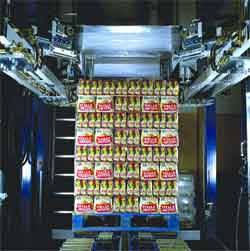January 29, 2014

Probably one of the most expensive statements in package engineering is "just to be safe." Its unquestioned acceptance likely accounts for more materials use than any other factor.
At its Leuven, Belgium, operation, Interbrew is challenging that statement and is proving that less can very well be more. By using a single ply of film to wrap pallet loads for European distribution of its popular Stella Artois beer, the brewer has, for the last 18 months, enjoyed some materials savings and–at 1 pallet/min–higher output, as well.
|
During stretch wrapping, mechanical grippers are wrapped with film and draw it down the full circumference of the load. |
But Nico van Tilt, at Interbrew's corporate engineering department, has other fish to fry: installation of a new automated hood stretch system, Lachenmeier's KL machine, motivated primarily by the exacting demands of automated warehousing, completed nearly a year earlier. Troubles that began to arise with previously used spiral stretch and shrink techniques, he recalls, included hanging film ends and loosening loads, which led to shelving and other problems–not to mention the visual impact of the presentation of punctures by forklift trucks.
For its 25-cL Stella Artois bottles, sold primarily in France, and two additional sizes of bottles and cans, pallet standardization is a given. This enables throughput at a 6,000-bottle/hr level on the automated packaging line through erecting and loading six-pack paperboard carriers.
With an equally standardized wooden pallet, the optimal load pattern is established and executed by a high-speed Kettner Pressant Universal palletizer from Krones. The filled pallet then conveys downstream to the hood stretch machine.
At this station, photocells establish the height of the pallet, and the tubular film–a 100-micron polyethylene copolymer produced by Fardis with macro-perforations–is activated by suction and held mechanically. It winds onto grippers, its far end sealed and cut by a knife. The grippers stretch the film hydraulically to a circumference that suits the load and apply it with optimal vertical and horizontal stretch.
For maximal load security, the grippers place the film under the pallet but out of reach of the forklift. As they withdraw, the finished load starts to convey downstream, and the photocells sense the next load's height.
Outside protection
While economizing on film by enabling a single tube size for all load configurations, the stretch-wrapping technique also permits outside storage of pallet loads. The film protects the load against severe weather conditions and negates the sun's impact on the six-pack carriers through an ultraviolet filter.
Nico van Tilt admits that the simplicity of the single film tube is a vast improvement over the spiral stretch. "It also improves production rates," he tells PD, "since it takes the decision regarding additional layers of film out of the operator's hands. This is where the problems started initially regarding our automated warehousing."
He recalls that, in seeking a pallet-wrapping system to replace those in use in Leuven, he traveled with packaging department associate Peter Sauer to Lachenmeier's test facility in Faxe, Denmark. Following this, he shipped several pallet loads for tests with the hood shrink system, which he calls "a machine that appeared to be very well-engineered, requiring only a minimum of maintenance." He adds, "And nothing that has happened since that time has changed my attitude. We are quite satisfied."
More information is available:
Stretch wrapper: Lachenmeier, 954/987-9945. Circle No. 223.
Palletizer: Krones/Kettner, 414/409-4000. Circle No. 224.
Film: Fardis, +32 14 61 50 31. Circle No. 225.
About the Author(s)
You May Also Like



